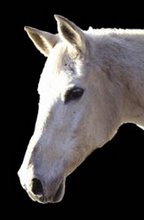This book is only about 100 pages long, but it if you want a truly information-packed resource on holistic horse health, practical advice, and an imagination inspiring nudge, you will want to get this one!
Jaime is a farrier/barefoot trimmer who studied wild horses in the high desert for 4 years in the 1980's. Being a farrier, he was especially interested in their feet, which were (obviously) never trimmed or cared for by humans. Domestic horses are prone to many different kinds of lamenesses, and a huge number of horses are chronically lame to some degree or other, even at very young ages, sometimes even before they are started under saddle. Farriers, vets, and horse owners spend a great deal of time and money each year treating lameness in horses, yet lameness issues are still some of the worst killers of horses. When Jaime realized that the wild horses he was watching were almost never lame despite traveling dozens of miles a day over all kinds of terrain, (soft, hard, rocky, slippery, sandy, wet, dry, and gravelly ground) he started thinking, and examining lots of cadaver hoofs, footprints, and photos of the wild horses. What he found caused him to rethink hoofcare, and revolutionized his techniques, especially in regard to use of typical horse shoes...
In the last couple decades, other horse people ended up on similar paths of questions and discovery, and now barefoot high-performance horses are becoming an accepted reality. And successful rehabilitation of thousands and thousands of "hopelessly" lame horses has caused an entire industry to rethink a lot of traditions and practices, for the good of the horse.
However, one thing that the various barefoot "gurus" have consistently found, is that movement, and LOTS of it, is far, far more important for the health of a horse's feet, (and whole body) than the particular style of trimming. Horses that stand in a stall or under a tree most of the day will never have hooves that reach their full potential, unlike horses that travel 20 miles a day or more.
So the dilemma for horse owners has been, how is it possible to provide enough room and motivation to encourage their beloved horses to move that much? Even in very large pastures, horses will often stand near the gate most of the day, swishing flies. We do not want "pasture potatoes," but very few of us horse owners have the resources to give our horses several thousand acres of open land to simulate a wild environment. Riding consistently is very good for horses, but they still tend to stand around the rest of the time.
So, what is the answer to this puzzle?!?
Part 2 coming tomorrow. :-)
L
Subscribe to:
Post Comments (Atom)


No comments:
Post a Comment